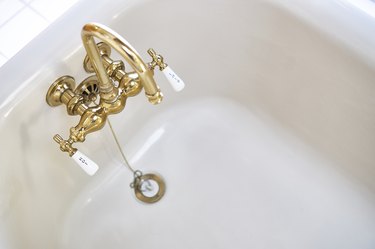
Insects like warm, cozy homes as much as you do. But despite your best efforts to discourage and evict these unwanted squatters, you might still find crickets in the bathtub or bathroom. In fact, your bathroom seems like a haven for these insects.
The reason you tend to find insects like crickets or spiders in your bathroom is because the space offers a moist environment. But it's highly unlikely that insects crawl up the bathtub drain. Instead, they crawl down into it, and feast on and breed in debris clogged in the drain.
Video of the Day
Video of the Day
Insects Don't Access Healthy Drains
Although horror movies like to use swarms of insects crawling up through the bathtub drain as a trope, in real life it is far less likely to happen if you have a frequently used drain in good working order. Think about the drain system: it should be completely closed from the bathtub drain all the way to the sewer. If holes exist along the way that crickets and other insects can access, your plumbing is in need of repair. Therefore, if you suspect insects frequently enter your home this way, call a plumber to investigate a leak.
Whether insects enter through the sewer access or a hole in a pipe closer to your home, they have to make their journey without getting swept away by water. Your home has one main sewer line that all waste water flows through. Whether you flush a toilet or turn on a sink, it all goes to the same pipe that the insects would have to crawl up in order to enter your bathtub drain. The chances of an insect making this journey without getting flushed down the pipe are slim, so if they do crawl up a pipe, it's likely an unused one.
Finally, drains have water traps intended to prevent sewer gas from getting into your home. These traps have to be tight in order to stop gas from leaking through. Therefore, they certainly do not allow enough space for an insect like a cricket or spider to wriggle through. Do you see insects and smell sewer gas? Time to call a plumber.
Insects Probably Use the Door or Window
If you find insects in your bathroom, a far more likely scenario for their entry involves gaps in the seals around your doors, windows or even around your foundation. Then, they make their way to your bathroom because they sense that it has a higher humidity than the rest of your house. The bathroom drain represents the ultimate destination for an insect because it's not only moist, but also dark and probably has some hair and gunk that could serve as a food source.
What Drain Bugs Really Mean
If you do find drain bugs in your kitchen sink, tiny black bugs in the bathroom sink, crickets in the bathtub or any other type of unwelcome crawler, then you probably have debris in your drain. Because water flow should normally flush insects down your sewer pipe, insects that don't seem to disappear have found something to cling to: hair, food scraps, oil, dirt and anything else that's wound its way into your drain.
They not only hide in drain debris, but can also breed in it. Therefore, the first step toward having a bug-free bathroom or kitchen involves thoroughly cleaning the drain. To ensure success, turn off the water supply valves under the sink and unscrew the U-bend to access a commonly clogged area. Dump any debris out of the U-bend pipe and use a special brush to scrub as much of the pipe as you can reach.
For a bathtub drain, remove the stopper and remove any debris that you can see and reach. If you suspect that a clog exists further down the drain because the bugs continue to appear or the water drains slowly, snake the drain.